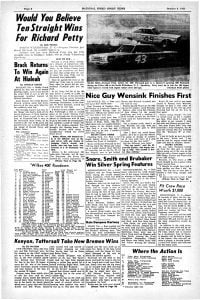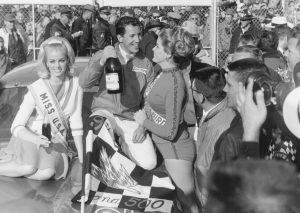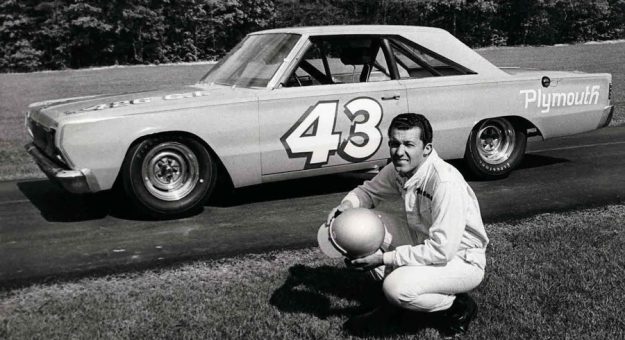Editor’s Note: NASCAR is celebrating its 75th anniversary in 2023. SPEED SPORT was founded in 1934 and was already on its way to becoming America’s Motorsports Authority when NASCAR was formed. As a result, we will bring you Part 20 of a 75-part series on the history of NASCAR as told in the pages of National Speed Sport News and SPEED SPORT Magazine.
What do 27 victories, a record-shattering 75-career triumphs, 5,537 laps led in 41 races, $150,197 in winnings and 10 victories in a row have in common? All are records that Richard Petty set in 1967.
“You just can’t keep going like this forever,” James Hylton told Richard Petty before the start of the Sept. 15 Beltsville (Md.) 300. “I don’t know if I’ll be the one to beat you, but somebody will.” Hylton, who finished second in the points, was right. Petty did not keep winning races indefinitely, only 10 straight.
Beginning with his victory in the Aug. 12 race in Winston-Salem, N.C., the No. 43 Plymouth graced victory lane after every race through the Oct. 1 North Wilkesboro (N.C.) Speedway, which was his 27th trophy of the season.
The trek to 27 began on Nov. 13, 1966 in Augusta, Ga., when Petty drove to victory on the half-mile asphalt track. The next time he wore the laurels came after a triumph in Weaverville, N.C., in March. Heretofore, Petty held two victories in 10 Grand National races; good numbers, but hardly dominant.
Petty Enterprises Gains Speed
This is when the mechanical talents and luck of Petty Enterprises came into play.

“Struggling” with the two Plymouth Belvedere GTXs they had built for 1967, the team decided to reskin the 1966 car with the 1967-style sheet metal and try its luck. Whether luck or talent played a greater role, Petty’s next 38 starts proved the soundness of the move.
The “1967” Plymouth won three of the next four beginning in Weaverville, N.C., and 25 of the next 38 races en route to Petty’s second Grand National title. Petty’s domination of victory lane frustrated more than the drivers he was outrunning every week.
In the Oct. 11 issue of NSSN, Bob Moore of the Charlotte (N.C.) Observer reported Ford Director of Competition Vehicles Jacques Passino fired driver Darel Dierenger for poor performance.
This event is not unusual by itself, but he also related an incident in the Ford pits during Petty’s 10th straight victory, which revealed the pressure Ford teams were under to defeat the No. 43 car.
During a pit stop early in the race, former driver Fred Lorenzen, who now worked on Ford’s race teams, asked Junior Johnson to retire for the day in favor of David Pearson, who had lost his ride to an oil leak earlier in the race. Johnson refused and an argument ensued which ended only when Johnson climbed in his Ford and sped back onto the track.
“The constant harping about beating Petty is putting too much strain on the Ford teams, Moore concluded. “The driver has got to be relaxed when racing, not worrying about being fired as has become the situation recently on Ford teams.”
Chrysler Cuts Back
Ironically, Petty’s success came with what Chrysler competition chief Ronney Householder said was 40-50 percent less financial assistance than 1966 when the car maker paid for cars, parts, engines and salaries for the factory teams. Chrysler’s racing program cutbacks meant that only the top car builders — Lee Petty, Norm Nelson, Ray Nichels and Cotton Owens — received assistance from the factory.
Chrysler’s cutbacks caused defending Grand National champion and Dodge Charger pilot Pearson to defect to Ford for the 1967 season. Yet, Chrysler’s cutbacks were motivated, in part, by Pearson’s expensive title run. The auto maker spent more than $200,000 to finance Pearson’s cars in 1966, but he only garnered $78,194 in prize money.
Of course, the publicity Chrysler received and the vehicles which were sold because of Pearson’s run in a Dodge Charger were not measured, but Chrysler felt NASCAR racing was too expensive and decided to cut back.
Key to the innovations behind the development of race tires was the involvement of Firestone and Goodyear Tire and Rubber companies in the NASCAR Grand National division. Both companies paid drivers to test tires and provided tires for top drivers.
Firestone Vs. Goodyear
However, by 1967 the cost of paying race teams to use one brand of tire exclusively had escalated to the point where Firestone decided to substantially cut back in NASCAR and concentrate on developing race tires for purchase.

Raymond C. Firestone, CEO of Firestone, commented in the Sept. 20 issue of NSSN, “The need to do a better job of engineering, developing and manufacturing a race tire became secondary to the question of how much (Firestone) pays to have drivers use our tires.”
Goodyear, on the other hand, accepted the tire contracts as part of racing.
A Goodyear spokesman said, “Contracts and agreements have become an integral part of the sport and it is impossible to maintain a foothold without also offering financial incentive to the participants. Goodyear will continue to compete in racing under whatever conditions exist at the time.”
The conditions governing Grand National car body styles changed in 1967. Body templates we-e used for the first time to ensure that body dimensions conformed to stock. L.A. (Lin) Kuchler, NASCAR’s executive manager, announced in the Jan. 11 issue of NSSN that a 2-inch high, 50-inch-wide penalty spoiler would be placed on all cars which did not conform to stock body shapes.
The penalized car could race for one event with a spoiler, but would have to conform to specifications before it could be raced again. ·
At the end of the season, Lee Petty was the top car owner for the fifth time. Carl Berghman reigned as the modified champion and Pete Hamilton was the sportsman king. Donnie Allison was named NASCAR’s Rookie of the Year.
